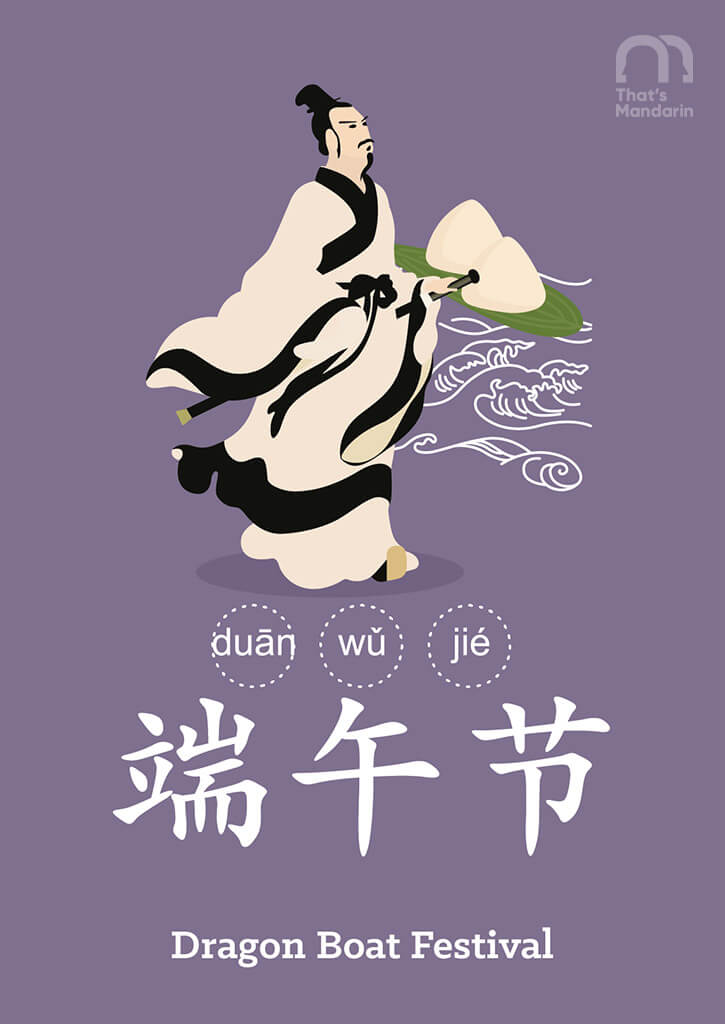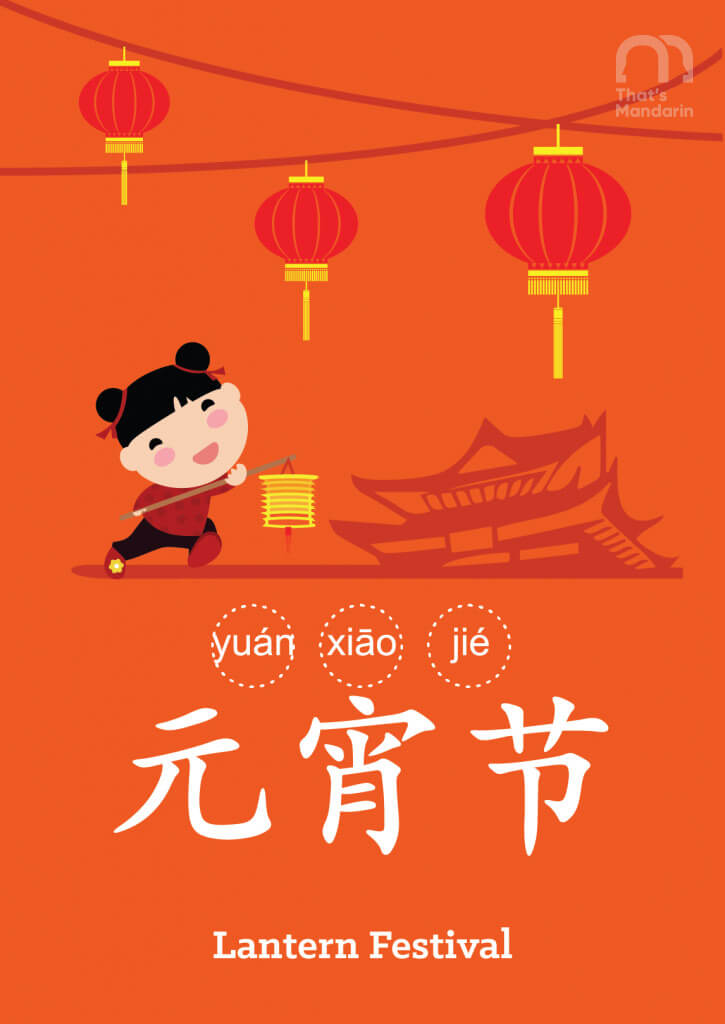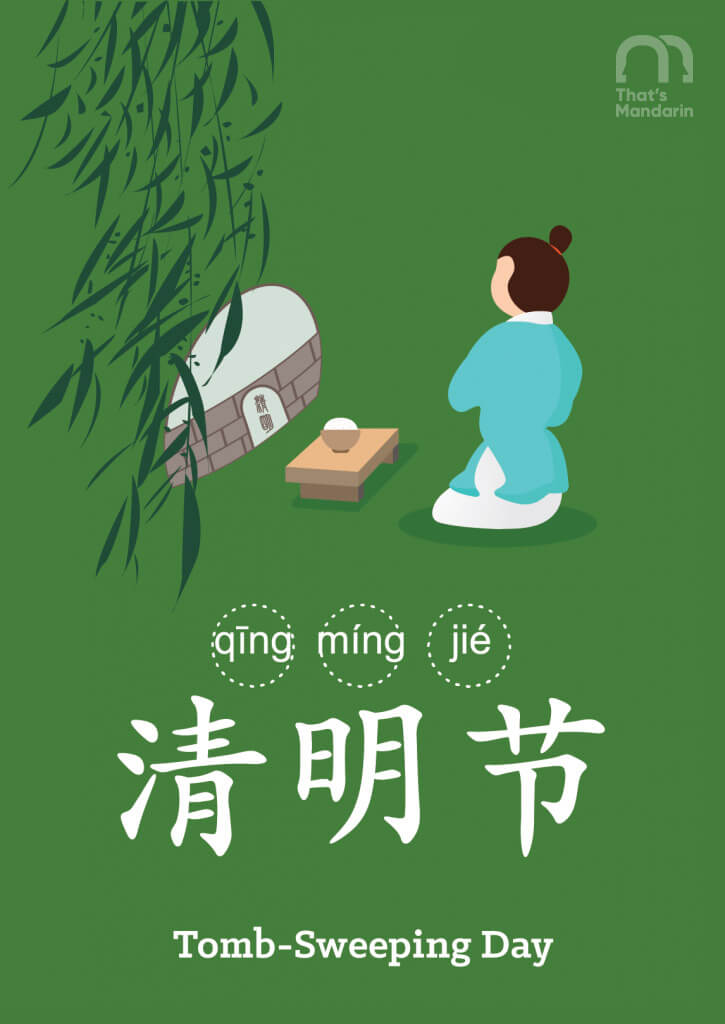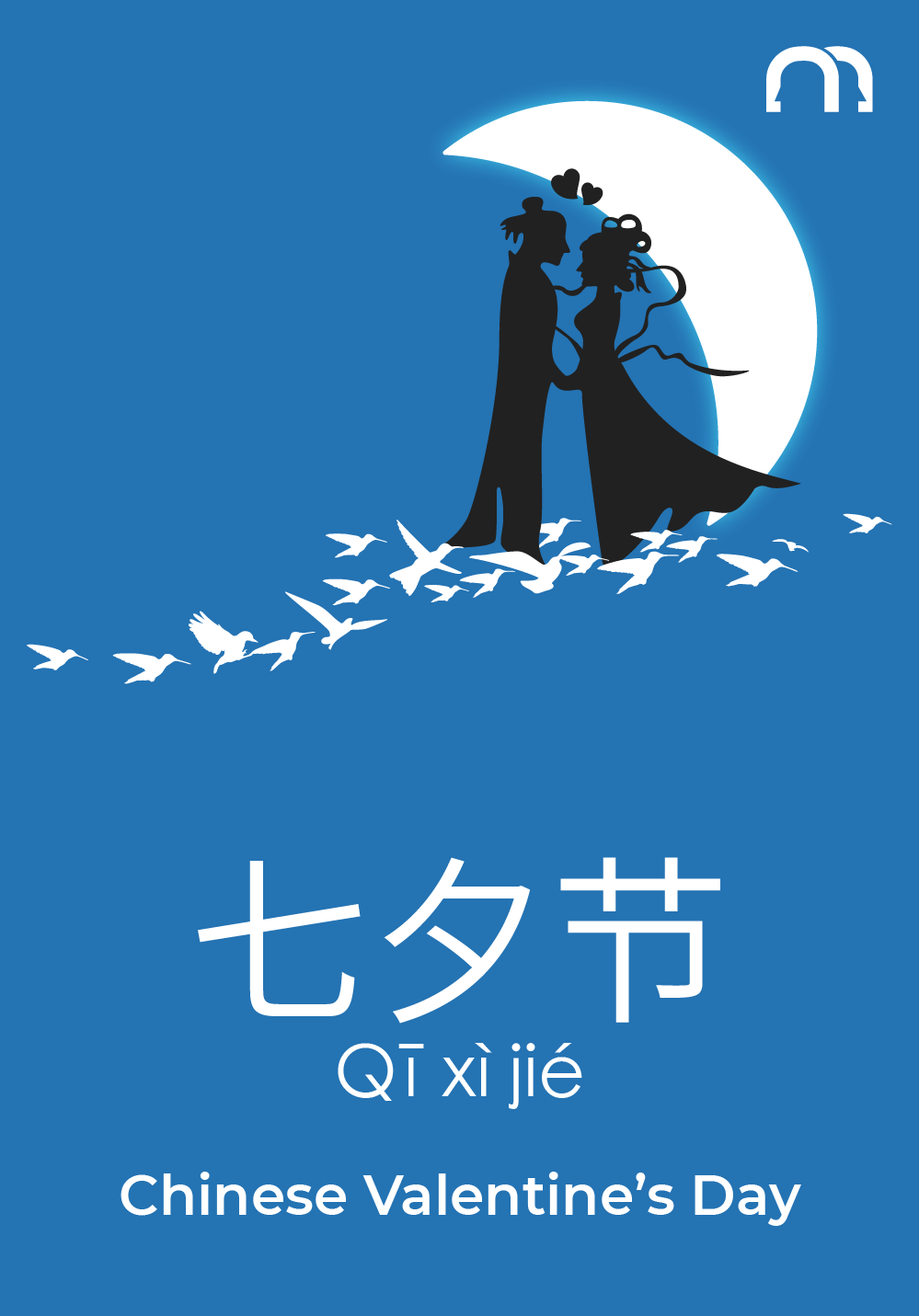Chinese Link Words: Chinese Festivals
Dragon Boat Festival | 端午节 (Duānwǔjié)
This Chinese tradition occurs on the fifth day of the fifth month of the traditional lunar calendar, called the Chinese Dragon Boat Festival or 端午节 (Duānwǔjié), which also means “double five festival”. Here 午 (wǔ) has the same meaning as 五 (wǔ), just like the pronunciation.
This festival commemorates the death of the poet and minister Qu Yuan (c. 340–278 BC) who lived in the ancient state of Chu during the Zhou Dynasty. As a cadet member of the Chu royal house, Qu served in high offices. However, when the king decided to ally with the increasingly powerful state of Qin, Qu was banished from his home for opposing this alliance and even accused of treason.
During his exile, Qu Yuan wrote a great deal of poetry. Twenty-eight years later, the Qin kingdom captured and overthrew Ying, the Chu capital. In despair, Qu Yuan committed suicide by drowning himself in the Miluo River.
Dragon boat racing finds its origins in the story of the poet Qu Yuan. When he threw himself in the river, all of the fishermen from his town raced their boats onto the water in an attempt to save him or at least retrieve his body. This then started the dragon boat, 龙舟 (lóngzhōu), races.
Most Chinese festivals include the eating of a particular food among their customs and the Dragon Boat Festival is no exception. 粽子 (zòngzi) is the customary food eaten in this case. Along with sticky rice, zongzi includes plain sugar zongzi, red bean zongzi, horse bean zongzi, date zongzi, rose zongzi, melon zongzi, and lard zongzi.
The Lantern Festival | 元宵节 (Yuánxiāojié)
The Lantern Festival, or 元宵节 (Yuánxiāojié), falls on the 15th day of the first month in the Chinese traditional lunar calendar. This date plays a special role because Chinese people usually celebrate Spring Festival from January 1st to January 15th, so this is the last carnival of the vacation.
What is the meaning of 元宵 (yuánxiāo) in 元宵节 (Yuánxiāojié)? That is a traditional Chinese food made from glutinous rice flour mixed with a small amount of water to form balls and is then cooked and served at boiling water.
元宵 (yuánxiāo) can be either small or large, and with or without filling. Very often, 元宵 (yuánxiāo) is filled with sesame. This flavor is delicious!
Another main component during the Lantern Festival is, of course, the lantern 花灯 (huādēng). During the Lantern Festival, every family will try their best to make their own lanterns and display them together. We call it the Exhibit of Lanterns , 灯会 (Dēnghuì). Everyone will go to 灯会 (Dēnghuì) and nighttime may be the liveliest nights of the whole year. Among the visitors, children will be the happiest. It is also a good opportunity for youngsters to join in the festivities.
Today, the lantern festival is still a major event throughout china with a glittery effect in the sky displaying an ocean of lanterns. Cities such as Hangzhou and Shanghai have electric and neon lanterns. The most stunning lantern is the dragon pole in the shape of a golden dragon. It spiral’s up a 38 meter pole and spews fireworks from its mouth.
Qingming Festival | 清明节 (Qīngmíngjié)
Qingming Festival, or 清明节 (Qīngmíngjié), is also known as the Tomb-sweeping Day because Chinese people visit the columbarium, graves or burial grounds to pray to their ancestors. It is usually on the 4th, 5th or 6th of April.
The Qingming Festival is an opportunity for celebrants to remember and honor their ancestors on their gravesites. The young and old pray before their ancestors, sweep the tombs and offer food, tea, wine, chopsticks, joss paper accessories, and libations to the ancestors. The rites have a long tradition in Asia, especially among farmers. Some people carry willow branches with them on Qingming or put willow branches on their gates and front doors. They believe that willow branches help ward off the evil spirit that wanders on Qingming.
The festival is founded by a King during the Spring and Autumn period as a memorial for his retainer Jie Zitui (介子推), who had loyally followed him during his years of exile. Supposedly, he once even cut meat from his own thigh to provide the king with soup when he was still one of the princes. Once the prince was enthroned as a king, Jie considered that his services were no longer required and he then resigned. Although the king was generous in rewarding those who had helped him in his time of need, he long passed over Jie, who had moved into the forest with his mother. The king went to the forest but could not find them. He then ordered his men to set fire to the forest in order to force Jie out. Jie and his mother were killed instead. The king was overcome with remorse and ordered three days without fire to honor Jie’s memory.
This is a sad story but people weren’t sad during the entire period of the Qingming Festival. After sweeping the tomb and communicating with their ancestors, people would feel refreshed and more energetic. So people often go for a walk in the country and enjoy the spring scenery during the festival.
You must have heard about the name, “Along the River During the Qingming Festival”, 清明上河图 (Qīngmíng Shàng Hé Tú). It is a painting by the Song dynasty artist Zhang Zeduan (1085–1145). It captures the daily life of people and the landscape of the capital from the Northern Song period. The theme is often said to celebrate the festive spirit and worldly commotion at the Qingming Festival, rather than the holiday’s ceremonial aspects. Successive scenes reveal the lifestyle of all levels of the society from rich to poor as well as different economic activities in rural areas and the city. It also offers a glimpse of clothing and architecture in different periods. The painting is considered to be the most renowned work among all Chinese paintings, and it has been called “China’s Mona Lisa.” Now it is in The Palace Museum in Beijing, and it is not usually open to the public.
Double Seven Festival | 七夕节 (Qīxījié)
The Chinese Valentine’s Day is different from the globally celebrated Valentine’s Day on February 14th. The Chinese version falls on the 7th day of the 7th month in the traditional Chinese lunar calendar and is also called the Double Seven Festival, or 七夕节 (Qīxījié).
This festival comes from a well-known legend: There was once a fairy called 织女 (zhīnǚ). She was the granddaughter of the powerful Jade Emperor in Heaven.
One day, she came down to earth with her friends and met a boy called 牛郎 (niúláng), which means “cowherd” in Chinese. This caused problems as they soon fell in love compelling Zhīnǚ to stay on Earth and marry Niúláng without her grandparents’ permission. However, they managed to live together for several years and had two children.
When her grandparents finally found out, they were outraged. It was absolutely unacceptable for a fairy to marry a human being. So the Jade Emperor kidnapped her and brought her back to Heaven. To completely block zhīnǚ from going back to Earth, he created the Milky Way. The lovers could no longer see each other and all Zhīnǚ could do was cry with grief on the other side of the Milky Way.
But that’s not the end of the story. The sound of her crying finally moved everyone. On the 7th day of the 7th month, thousands of magpies gathered together and used their bodies to build a bridge across the Milky Way. Then niúláng and zhīnǚ were able to see each other again! From then on, this day became the only time that they could be together.
Why do Chinese people love this legend so much? This is probably because, in ancient China, the marriage of the youngsters was always decided by their parents according to which class the family belonged to in society. Youngsters didn’t have the opportunity to find their lovers by themselves. Many of them didn’t even get to meet their future spouse before the wedding. And so, people dreamed to experience true love like niúláng and zhīnǚ, even if just for one day every year.
祝大家七夕节快乐!
Zhù dàjiā Qīxījié kuàilè!
Dragon Boat Festival | 端午节 (Duānwǔjié)
This Chinese tradition occurs on the fifth day of the fifth month of the traditional lunar calendar, called the Chinese Dragon Boat Festival or 端午节 (Duānwǔjié), which also means “double five festival”. Here 午 (wǔ) has the same meaning as 五 (wǔ), just like the pronunciation.
This festival commemorates the death of the poet and minister Qu Yuan (c. 340–278 BC) who lived in the ancient state of Chu during the Zhou Dynasty. As a cadet member of the Chu royal house, Qu served in high offices. However, when the king decided to ally with the increasingly powerful state of Qin, Qu was banished from his home for opposing this alliance and even accused of treason.
During his exile, Qu Yuan wrote a great deal of poetry. Twenty-eight years later, the Qin kingdom captured and overthrew Ying, the Chu capital. In despair, Qu Yuan committed suicide by drowning himself in the Miluo River.
Dragon boat racing finds its origins in the story of the poet Qu Yuan. When he threw himself in the river, all of the fishermen from his town raced their boats onto the water in an attempt to save him or at least retrieve his body. This then started the dragon boat, 龙舟 (lóngzhōu), races.
Most Chinese festivals include the eating of a particular food among their customs and the Dragon Boat Festival is no exception. 粽子 (zòngzi) is the customary food eaten in this case. Along with sticky rice, zongzi includes plain sugar zongzi, red bean zongzi, horse bean zongzi, date zongzi, rose zongzi, melon zongzi, and lard zongzi.
The Lantern Festival | 元宵节 (Yuánxiāojié)
The Lantern Festival, or 元宵节 (Yuánxiāojié), falls on the 15th day of the first month in the Chinese traditional lunar calendar. This date plays a special role because Chinese people usually celebrate Spring Festival from January 1st to January 15th, so this is the last carnival of the vacation.
What is the meaning of 元宵 (yuánxiāo) in 元宵节 (Yuánxiāojié)? That is a traditional Chinese food made from glutinous rice flour mixed with a small amount of water to form balls and is then cooked and served at boiling water.
元宵 (yuánxiāo) can be either small or large, and with or without filling. Very often, 元宵 (yuánxiāo) is filled with sesame. This flavor is delicious!
Another main component during the Lantern Festival is, of course, the lantern 花灯 (huādēng). During the Lantern Festival, every family will try their best to make their own lanterns and display them together. We call it the Exhibit of Lanterns , 灯会 (Dēnghuì). Everyone will go to 灯会 (Dēnghuì) and nighttime may be the liveliest nights of the whole year. Among the visitors, children will be the happiest. It is also a good opportunity for youngsters to join in the festivities.
Today, the lantern festival is still a major event throughout china with a glittery effect in the sky displaying an ocean of lanterns. Cities such as Hangzhou and Shanghai have electric and neon lanterns. The most stunning lantern is the dragon pole in the shape of a golden dragon. It spiral’s up a 38 meter pole and spews fireworks from its mouth.
Qingming Festival | 清明节 (Qīngmíngjié)
Qingming Festival, or 清明节 (Qīngmíngjié), is also known as the Tomb-sweeping Day because Chinese people visit the columbarium, graves or burial grounds to pray to their ancestors. It is usually on the 4th, 5th or 6th of April.
The Qingming Festival is an opportunity for celebrants to remember and honor their ancestors on their gravesites. The young and old pray before their ancestors, sweep the tombs and offer food, tea, wine, chopsticks, joss paper accessories, and libations to the ancestors. The rites have a long tradition in Asia, especially among farmers. Some people carry willow branches with them on Qingming or put willow branches on their gates and front doors. They believe that willow branches help ward off the evil spirit that wanders on Qingming.
The festival is founded by a King during the Spring and Autumn period as a memorial for his retainer Jie Zitui (介子推), who had loyally followed him during his years of exile. Supposedly, he once even cut meat from his own thigh to provide the king with soup when he was still one of the princes. Once the prince was enthroned as a king, Jie considered that his services were no longer required and he then resigned. Although the king was generous in rewarding those who had helped him in his time of need, he long passed over Jie, who had moved into the forest with his mother. The king went to the forest but could not find them. He then ordered his men to set fire to the forest in order to force Jie out. Jie and his mother were killed instead. The king was overcome with remorse and ordered three days without fire to honor Jie’s memory.
This is a sad story but people weren’t sad during the entire period of the Qingming Festival. After sweeping the tomb and communicating with their ancestors, people would feel refreshed and more energetic. So people often go for a walk in the country and enjoy the spring scenery during the festival.
You must have heard about the name, “Along the River During the Qingming Festival”, 清明上河图 (Qīngmíng Shàng Hé Tú). It is a painting by the Song dynasty artist Zhang Zeduan (1085–1145). It captures the daily life of people and the landscape of the capital from the Northern Song period. The theme is often said to celebrate the festive spirit and worldly commotion at the Qingming Festival, rather than the holiday’s ceremonial aspects. Successive scenes reveal the lifestyle of all levels of the society from rich to poor as well as different economic activities in rural areas and the city. It also offers a glimpse of clothing and architecture in different periods. The painting is considered to be the most renowned work among all Chinese paintings, and it has been called “China’s Mona Lisa.” Now it is in The Palace Museum in Beijing, and it is not usually open to the public.
Double Seven Festival | 七夕节 (Qīxījié)
The Chinese Valentine’s Day is different from the globally celebrated Valentine’s Day on February 14th. The Chinese version falls on the 7th day of the 7th month in the traditional Chinese lunar calendar and is also called the Double Seven Festival, or 七夕节 (Qīxījié).
This festival comes from a well-known legend: There was once a fairy called 织女 (zhīnǚ). She was the granddaughter of the powerful Jade Emperor in Heaven.
One day, she came down to earth with her friends and met a boy called 牛郎 (niúláng), which means “cowherd” in Chinese. This caused problems as they soon fell in love compelling Zhīnǚ to stay on Earth and marry Niúláng without her grandparents’ permission. However, they managed to live together for several years and had two children.
When her grandparents finally found out, they were outraged. It was absolutely unacceptable for a fairy to marry a human being. So the Jade Emperor kidnapped her and brought her back to Heaven. To completely block zhīnǚ from going back to Earth, he created the Milky Way. The lovers could no longer see each other and all Zhīnǚ could do was cry with grief on the other side of the Milky Way.
But that’s not the end of the story. The sound of her crying finally moved everyone. On the 7th day of the 7th month, thousands of magpies gathered together and used their bodies to build a bridge across the Milky Way. Then niúláng and zhīnǚ were able to see each other again! From then on, this day became the only time that they could be together.
Why do Chinese people love this legend so much? This is probably because, in ancient China, the marriage of the youngsters was always decided by their parents according to which class the family belonged to in society. Youngsters didn’t have the opportunity to find their lovers by themselves. Many of them didn’t even get to meet their future spouse before the wedding. And so, people dreamed to experience true love like niúláng and zhīnǚ, even if just for one day every year.
祝大家七夕节快乐!
Zhù dàjiā Qīxījié kuàilè!
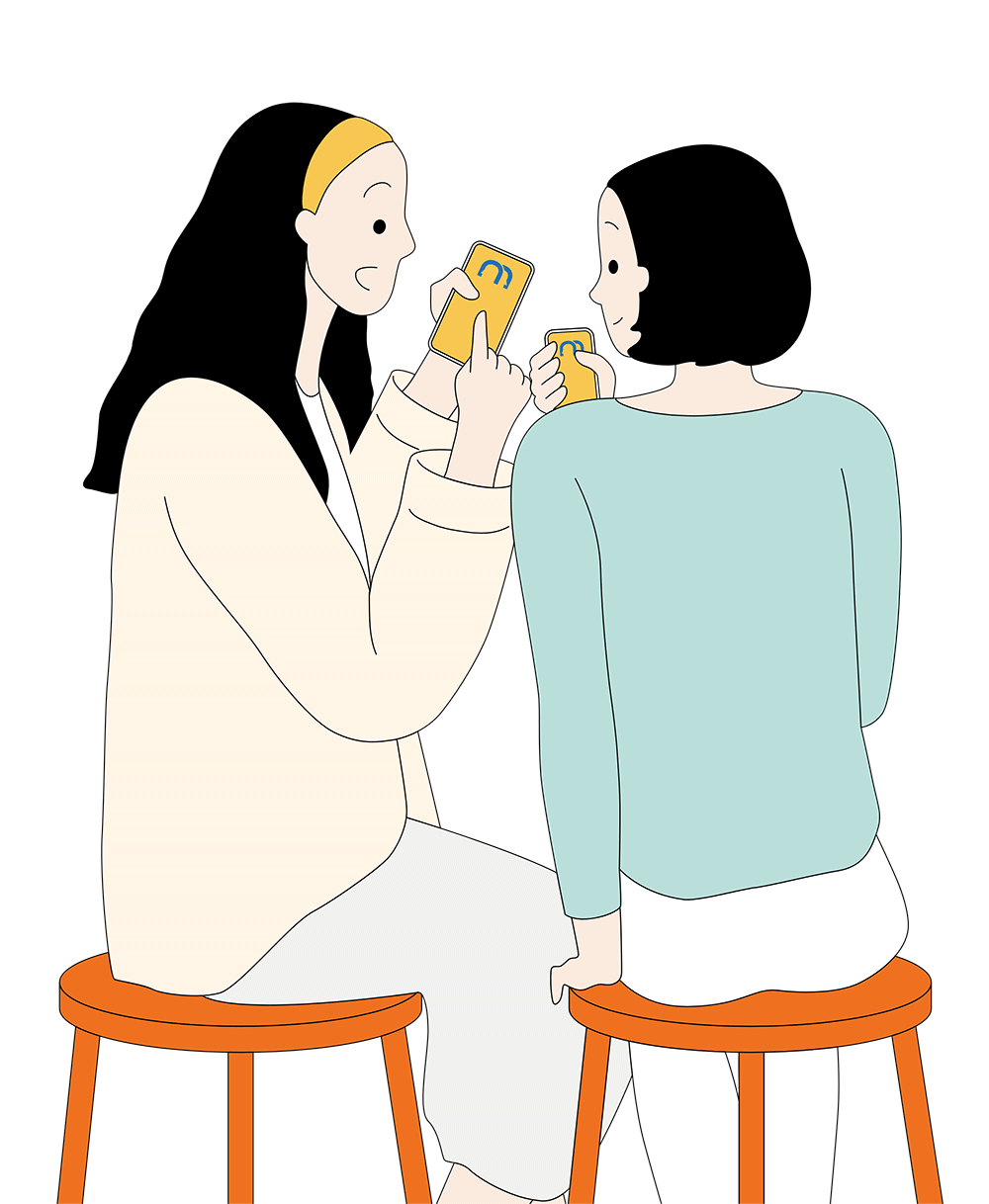
Study Chinese
with us
Learn More About Our Programs
Study Chinese with us
Learn More About Our Programs


